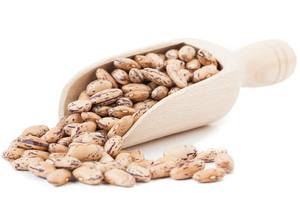Drying beans & peas at home isn’t difficult and you don’t need any special equipment. We often grow borlotti beans, dry them and store to use in the kitchen

Dried Borlotti Beans
Runner beans and dwarf & climbing French beans where you eat the pod aren’t suitable for drying. They are better, salted, bottled or frozen. However haricot beans, where we eat the bean rather than the pod and marrowfat peas are good subjects for drying.
We tend to eat quite a lot of dried beans and pulses. Chickpeas, lentils, red-kidney beans and so forth as well as home grown beans like Borlotti. Beans are an excellent source of high quality protein and fibre.
For many years these vegetable proteins were viewed as second class but these days we know better. Not just high in protein, they’re low in fat which is more than can be said for most meats.
Traditional Method of Drying Beans & Peas
The traditional method was to leave the beans in pods on the plant for as long as possible. Once the weather changed the vines were uprooted and hung under cover, a greenhouse being most often used. When the pods were brittle, the beans were shelled and stored.
Being reliant on the weather, the traditional method of drying beans was pretty hit and miss. Improperly dried beans would often develop mould and not be fit to eat. The same problem often hit saved seed.
Oven Drying Beans
You can dry beans and peas in an oven if you don’t have a dehydrator. The best type of oven is an electric fan oven but a standard or a gas oven will do the job. Please note that beans dried in this manner are not suitable for sprouting as the blanching kills the germ.
- Pod your peas or beans and drop into cold water. The reason for this is you may well have a few pea maggots and they will float out in the water.
- Now blanch for about three minutes. Since they inevitably slip through the holes in a blanching basket, we just drop them straight into the blanching water and then use a fine sieve to fish them out.
- Don’t cool after blanching, just dry them on a towel before spreading onto trays and drying in the oven. The ideal is to dry at a temperature starting at 50°C/120°F/Gas Mark 0 and then increase the temperature slowly up to 65°C/150°F/Gas Mark 0.
The beans and peas are dry when they are quite crisp. Depending on their size, this takes between 2-3 hours. Pack in tightly corked bottles or airtight containers and store in a dry, dark place.
Usually you should soak dried beans and peas in cold water for about 12 hours to fully re-hydrate them before use. If you’re in a hurry, simply put your beans or peas into a large saucepan with plenty of cold water. Bring to the boil and boil vigorously for two or three minutes. Remove from the heat, cover the pan and leave for three quarters to an hour by which time they should be re-hydrated.
More on Drying & Dehydration
- Drying Apples & Pears – How to Dry Apples & Pears
- Drying Apricots, Peaches, Plums – How to Dry Apricots etc.
- Drying Fruits – How to Dry and Store Fruits, Fruit Leather
- Drying Runner & French Beans – How to Dry Runner & French Beans
- Drying Herbs – How to Dry and Store Herbs
- Drying Vegetables – How to Dry and Store Vegetables
- Sun Dried Tomatoes – How to Dry Tomatoes
- Drying Beans & Peas – How to Dry Beans & Peas at Home
- Drying Onions – How to Dry Onions


